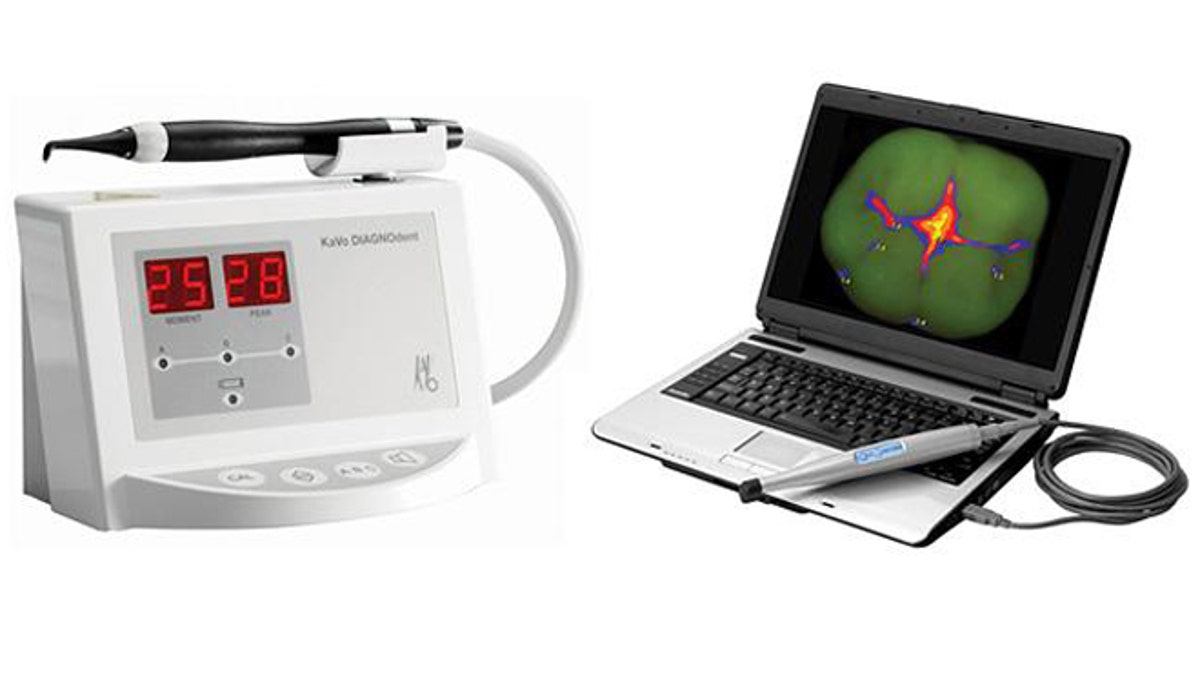
Emerging devices like Kavos popular Diagnodent (left) and Air Techniques Spectra (right) have been accused of helping dentists drum up business with unnecessary drillings.
Dental patients afraid of visiting the dentist may have a new reason to worry, according to experts who say an increasingly popular laser technique doesn’t deliver on its promise of early cavity detection.
So called “laser fluorescence” detectors like Kavo’s popular Diagnodent and Air Technique’s Spectra purport to assist in the early detection of surface cavities (called dental caries or occlusals). But experts say the new devices are easily abused, and can lead to unnecessary dental surgery.
“They’re not necessary,” ADA spokesman Matthew Messina told FoxNews.com. “We can do excellent dental work with traditional X-ray, visual, and hand exams alone.”
A study published in April by the American Dental Association concurs, finding “a large number of false-positive results with these devices, which limits their use as a principal diagnostic tool.” Traditional visual exams and X-rays remain the preferred diagnostic method since they are more than enough to root out cavities, the study found.
But that hasn’t stopped the gadgetry from becoming a staple in many dental offices around the nation, however. According to the ADA, laser fluorescence use in dentist's offices rose from 10 percent in 2003 to to 16 percent in 2006, the most recent data available. Assuming growth stayed constant, it’s possible the gizmos may be used by more than one in four dentists.
Las Vegas resident Michelle Smith claimed the number of cavities diagnosed in her son jumped from zero to four between six-month check-ups, but only after his dentist acquired a Diagnodent. She sought a second opinion from another dentist, who detected and treated only one verified cavity.
'These devices don’t give me anything I can’t do without hand, eye, or X-ray.'
Ben Taylor, an Atlanta resident, told FoxNews.com his most recent traditional dental exams came back clean. But his dentist insisted on drilling and filling three alleged cavities detected by the Diagnodent. Like Smith, Taylor sought a second opinion. He was pronounced cavity-free.
Since few dental patients actually seek out a second opinion, however, it’s unclear how much prevalent potentially unnecessary drilling has become in the decade since the birth of laser fluorescence detection.
Kavo Dental, the maker of the Diagnodent, declined to comment when contacted by FoxNews.com.
Air Technique, which makes the Spectra, acknowledged that the devices are susceptible to misuse. But the company disagreed with the report published by the ADA. “I think there’s a fair amount of accuracy, so I’m not sure what the ADA is basing their claims on,” said assistant marketing manager Jennifer Healey.
Not only that, but they’ve built a better mousetrap, said John Newman, a product specialist with the company. “Our product is less susceptible [to misreads] since it doesn’t need to be calibrated and is much easier for dentists to operate,” he told FoxNews.com.
Newman said fluorescent detectors like the Spectra aim to achieve non-invasive dentistry. And while acknowledging that mistakes can happen, he said the Spectra was designed as a monitoring tool, in addition to a diagnostic one, and can’t be blamed for misuse.
“The fact that some doctors are getting overzealous and opening up teeth when using the device is not our fault,” he said.
Fluorescent aids aren’t cheap, and sell for around $30,000, said the ADA’s Dr. Messina. And several dentists find the expensive gear invaluable.
North Carolina dentist Robert Stanley told FoxNews.com his Diagnodent has rooted out massive “iceberg” cavities below the surface that his eyes, hands, and X-rays would have otherwise missed.
“I’ve never opened up a tooth and been wrong,” he said. “This is really a good product helping a specific group of people.”
Messina said it’s important to remember that teeth can sometimes repair themselves over time with flossing, brushing, and fluoride treatments at home. And since regular dental exams can keep a close eye on any areas of concern, treating teeth based on a positive fluorescence diagnosis alone could be premature — a solution looking for a problem.
“I want to put things in my office that really make us better,” Messina said. “These devices don’t give me anything I can’t do without hand, eye, or X-ray.”
Even Stanley acknowledged that in the wrong hands, fluorescent aids could unfortunately be used to open up teeth that don’t need treatment.
“Find a dentist that you trust to do the right thing,” he says, “And know that these devices should never be used as standalone diagnostic tools.”
Since 2005, Blake Snow has written for half of the top 20 U.S. media. He’s had more than a dozen cavities filled, one root canal, and is grateful for all the honest dentists that have treated him. He is currently writing a book on finding offline balance in an online world.
